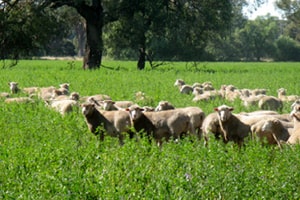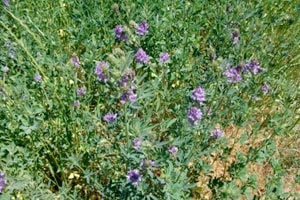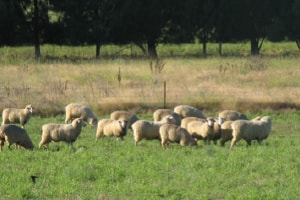Grazing sheep on lucerne

In Victoria lucerne can grow in soils that are well drained, slightly acidic (pH (CaCl2) of at least 5.5) to alkaline, with annual rainfall between 250 to 800mm.
Lucerne does not tolerate waterlogging.
Nutritive characteristics
Lucerne has high crude protein (average 22 to 27% over the year), low fibre (average 32-40% over the year), comparing favourably with perennial ryegrass, chicory and tall fescue. Metabolisable energy of lucerne averages 11.0MJ per kg dry matter over the year but has been shown to reduce to 10.2 MJ per kg dry matter in the summer-autumn period. Growth rates of 300 g/head/day in lambs are achievable with lucerne.
How the lucerne plant works
Lucerne is a resilient perennial legume that is grown for grazing and hay forage across temperate areas of the world.
Lucerne is resilient because it has a large tap root (Figure 1) that can reach deep into the soil, accessing both nutrients and water. The tap root also serves as a storage organ for nitrogen and carbohydrates (sugars and starches) that are required for the plant to regrow after grazing or cutting.
 Lucerne's resilience is also based on the development of the crown at the top of the tap root. The crown has basal buds that develop into new stems and leaves when environmental conditions allow.
Lucerne's resilience is also based on the development of the crown at the top of the tap root. The crown has basal buds that develop into new stems and leaves when environmental conditions allow.
It is appropriate to think of the lucerne plant as a pump. Most pumps do not pump water without having first being 'primed' or filled with water. The tap root and crown of the lucerne pump act as the priming mechanism for the plant.
In order for the lucerne plant to 'pump' or regrow, it must have sufficient reserves on which to draw when rainfall, temperature and day length combine to provide optimum conditions for growth. If the plant has been weakened through grazing, insect and disease attack or lack of fertility, then the pump will not be sufficiently primed and regrowth will not be optimal.
When a lucerne plant is grazed by sheep, the leaves are consumed first as these are the most digestible parts of the plant, followed by the stems. The loss of leaves and stems, or capacity for photosynthesis, provides a signal to the plant to draw on its reserves (predominantly carbohydrates) and that of the surrounding soil to produce new stems and leaves.
Once new leaves are formed, photosynthesis increases and sunlight is used as energy to produce carbohydrates to support further growth. The use of carbohydrates from the crown or root system then ceases. Later in the growth cycle, when the canopy is more developed, the plant starts to store carbohydrates in the taproot for future use.
 The lucerne plant is triggered to flower when temperatures start to cool and the day length shortens, or when the lucerne hasn't been grazed for a period of time. (Figure 2).
The lucerne plant is triggered to flower when temperatures start to cool and the day length shortens, or when the lucerne hasn't been grazed for a period of time. (Figure 2).
Some management guidelines recommend allowing lucerne plants to flower each year. This is based on the concept that flowering coincides with maximum carbohydrate storage in the crown and tap root.

Lucerne dormancy rating
Lucerne cultivars are categorised according to their level of dormancy during winter. The dormancy rating explains a large part of the genetic variation between cultivars in their seasonal growth pattern.
Lucerne cultivars with a high rating (8 to 11) are highly winter active while cultivars with a low rating (1 to 3) are winter dormant (Table 1). These comparisons are relative as the winter growth rates of winter active cultivars may be less than that of annual pastures at this time of year.
Highly winter active cultivars are more upright in their growth than winter dormant cultivars, and have their crown more exposed above the soil surface. This means that grazing highly winter active cultivars needs close observation so as not to damage the lucerne crowns.
Cultivars with a low rating may be more resistant to the grazing and trampling effects of sheep.
Table 1. Dormancy rating and growth description
Dormancy | Growth |
|---|---|
1 to 3 | Winter dormant — no winter growth, short season |
4 to 5 | Semi-dormant — little winter growth, good summer quality for hay or grazing |
6 to 7 | Winter active — good growth year round if seasonal conditions allow |
8 to 9 | Highly winter active — winter growth and fast recovery from grazing |
10 to 11 | The most winter active — best suited to summer rainfall areas for short term hay stands |
Grazing period
How long a lucerne stand is grazed by sheep depends on the amount of available dry matter in the paddock and the mob size (Figure 4). Producers should be interested in optimising forage utilisation — getting the best forage into the most animals when the animals require it and when the forage is at its most nutritious.
 The grazing period needs to be kept short (7 to 10 days) to ensure that the new shoots at the base of the plant are not consumed. Paddock and mob size need to be appropriate to allow the herbage available to be consumed in this period.
The grazing period needs to be kept short (7 to 10 days) to ensure that the new shoots at the base of the plant are not consumed. Paddock and mob size need to be appropriate to allow the herbage available to be consumed in this period.
For example, assuming a pre-grazing feed on offer (FOO) is 2000kg per hectare and residual FOO is 1000kg per hectare, 1000kg per hectare of forage is available. To consume this forage in 7 to 10 days will require about 100 DSE per hectare (stock consume approximately 1kg per DSE per day)'. A similar calculation can be done for cattle.
In other circumstances where optimal forage utilisation may not be required, longer grazing periods may be implemented. Some research has shown that longer periods of grazing (2 to 3 weeks) may be tolerated by a lucerne stand, provided that the overall amount of grazing time over the course of a year is no more than about 30%.
The rest period between grazing
Traditionally, lucerne is allowed to grow for about 6 weeks between grazing episodes. In the first 2 to 3 weeks after grazing, carbohydrates are mobilised from the tap roots and the crown to grow stems and leaves. From weeks 3 to 6, photosynthesis from the leaves and stems allows carbohydrates to be produced which are translocated back to the crown and tap roots.
This stage is often identified by the presence of a second flush of new stems and leaves. If grazing occurs after only 3 weeks rest — the lucerne plant does not have sufficient time to replenish roots and over time — the plant is weakened, production declines and the plant will not persist.
In research conducted at Rutherglen and Hamilton from January 2015 until June 2016, SARDI 7 lucerne cut every 3 weeks had lower total dry matter production in comparison to lucerne that was cut every 6 weeks (Table 2).
Table 2. Total herbage dry matter removed (kg/ha) from lucerne stands between January 2015 until June 2016 at Rutherglen and Hamilton. The stands were harvested every 3 weeks, 6 weeks, when new shoots appeared from the crown, or when old stems flowered.
Cutting system | Rutherglen | Hamilton |
|---|---|---|
3 weeks | 7800 | 12,100 |
6 weeks | 11,000 | 15,000 |
New shoots appeared | 10,000 | 11,700 |
Old shoots flowering | 9700 | 12,900 |
The second flush of new shoots may appear in less than 6 weeks during the peak spring growing season. It has been recommended that lucerne could be grazed when these new shoots appeared and were at least 2cm in length.
Recent research has demonstrated that if the presence of these new shoots is used as a criterion for grazing, irrespective of the time period that the lucerne has been rested from grazing, production will be lower than a regular 6-week rotation (compare 'new shoots' with '6 weeks' in Table 2).
 Similarly, previous recommendations have suggested that lucerne should be allowed to flower in late autumn to enable the root system to recover before the cooler winter months. This recommendation did not result in any dry matter advantage over the 6-week rotation treatment (Table 2).
Similarly, previous recommendations have suggested that lucerne should be allowed to flower in late autumn to enable the root system to recover before the cooler winter months. This recommendation did not result in any dry matter advantage over the 6-week rotation treatment (Table 2).
Therefore a rest period based on time (6 weeks) is considered the optimum for production and persistence rather than using plant indicators (for example shoot appearance or flowering).
It is important to not let the non-grazing interval get too long (longer than 6 weeks) as this will lead to reduced forage quality and increase the risk of leaf drop on extremely hot days. It is better to utilise the lucerne forage when it is in its vegetative stage, even if there is low dry matter, than to 'save' it for later.
Animal health risks
Lucerne dominant pastures can present a risk of bloat or red-gut in sheep. Red-gut is caused by the rapid passage of high quality feed through the digestive system and can result in death. Bloat is caused by the formation of rumen gases from fermentation of food material.
The gases form small bubbles in the rumen (similar to a stable foam) and affect the efficiency of the animal's belching mechanism. Lucerne can also form a solid mass (more so than other grass pastures) in the rumen and this can affect the animal's ability to belch.
When grazing lucerne pastures with sheep:
- Introduce sheep to lucerne gradually so that their rumen gut biology can adapt.
- Introduce lambs to lucerne prior to weaning. This ensures the lambs are taught how to graze lucerne from the mothers and will mean they are more familiar with the forage after weaning.
- Do not put hungry sheep on fresh lucerne pastures, such as might be seen in spring or after summer rainfall events.
- Provide hay roughage when grazing sheep on lucerne — alternatively, allow sheep access to grass pastures at the same time so they can choose a combination of legume and grass.
- Monitor sheep closely for signs of health risks or illness when grazing lucerne.
Key messages
- Lucerne has a large taproot that stores carbohydrates for regrowth after grazing —improving the persistence of lucerne plants is therefore about allowing plants to recover in order to replenish the store.
- The dormancy rating or amount of winter activity, affects the plants' susceptibility to grazing. Plants that are highly winter active require close observation to ensure the crown of the plant is not damaged when grazed.
- Grazing periods of 7 to 10 days are recommended.
- Rest periods of 6 weeks allows plants to replenish taproot reserves — 6 weeks is a better guideline than the appearance of new shoots or flowering.
- To minimise the animal health risks when lucerne is grazed, do not introduce hungry or unaccustomed sheep to lucerne and allow access to other pasture or hay.
More information
For more information see:
- Evergraze — gives information about perennials
- Pasture Improvement Initiative — break-down of the lucerne plant